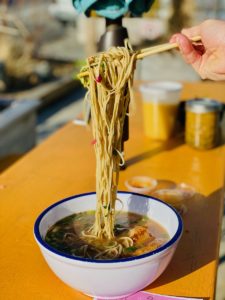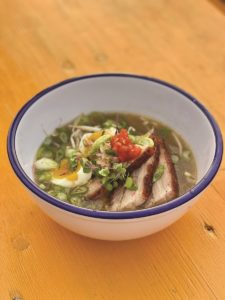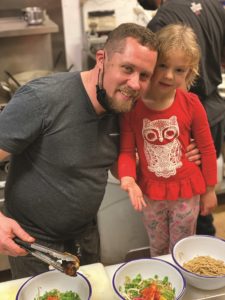PROVINCETOWN — The last year has hit the restaurant world hard. “I’m not sure other people can really grasp what it has meant for those of us in it,” says Liam Luttrell Rowland.
You figure there’s a certain kind of daring to being a restaurant person. The work can be creative, but also crushing. You know your career will involve some drama. You plan to roll with it.
“But when things shut down last March, it was different,” says Rowland, “because it was dramatic for everyone, all at once.”
In late February 2020, Rowland was in Barcelona, eating meals that lasted for hours and thinking about what new flavors might inform the season ahead at Spindler’s in Provincetown, where he was executive chef. He was feeling good about being named one of New England’s new culinary leaders, an honor conferred by Ocean Spray.
“A couple of weeks later, there was nothing,” he says. “No James Beard Awards, no executive chef jobs, no way for anybody to open something new — or even make what they were already doing viable.”
Survival mode, for him, meant staying at home in Wellfleet with his daughter, Nova, while his wife, Rachel Rowland, forged ahead with nursing school.
It also meant remembering ramen.

After cooking the gamut on the Outer Cape, at the Juice and Enzo’s and Blackfish, Rowland spent eight years in Asheville, N.C., where he met Elliott Moss, a James Beard best chef nominee, at a restaurant called The Admiral. “We ate two things: tacos and ramen,” he says. “Those were our kitchen meals, and they were so sustaining.”
One reason that ramen tasted so good was the addition of layers of umami — earthy, meaty, savory notes. “Elliott and I added kombu and bonito flakes to good chicken stock,” he says. “Once you do that, there’s no going back.”
Even before there was Momofuku and America’s ramen wave, were there not those little packages of instant noodles and salty seasonings to be boiled in college dorm hot pots? But Rowland was not that kind of college student. His roommate, Minori Hinds — now a comic in Atlanta — taught him the secrets to making good vegan miso, including the layering of seaweed in the broth.
These memories of the heady broths behind good ramen helped Rowland get through the winter and on to “the slow progression of getting ready to cook again.”
He got two broths underway — one vegan, one chicken, made from the blue-footed variety. He wanted to make his own ramen noodles, and in researching them learned they’re “low-hydration,” which makes a stiff dough. So stiff, in fact, it broke his home-model pasta machine.
“I went over to talk to Bob Montano about it — he knows everything about pasta,” says Rowland. Montano (of the eponymous Truro restaurant) offered the use of an extruder, should Rowland get serious about ramen-making. Which led to a conversation with the folks at the Provincetown Brewing Co., who liked the idea of hosting a noodle bowl pop-up. Soon, with a little help from his Instagram-savvy friend DJ Emerson Breneman and chef Raina Stefani making desserts, the idea came into being with “Ramen Wednesdays.” It’s called Farm_Stand.
The spring Wednesdays have been an outlet for Rowland’s farm-focused quest and also a way to raise awareness about the challenges restaurants still face. An estimated 211,000 restaurant jobs have been lost in Massachusetts due to Covid, according to the National Restaurant Association.
Two dollars of every ramen order goes to Mass. Restaurants United, which advocated for the Restaurants Act (part of the Covid-19 rescue bill just passed), has established a Distressed Restaurant Fund, and brings restaurant workers together to work on how to recover.
“The fact is,” Rowland says, “this is not over for restaurants, at least not for those that are really small businesses. We need a real change of mindset on that. We need to support each other.”
Rowland wants people to realize how radical the struggle is for restaurants that are coming back now. And for cooks like him. “By necessity, my food had to get simpler,” he says. “Nobody needed the kind of cooking I was doing. Experienced-based dining wasn’t going to happen. What was needed was something that could go home in a box. For nearly a year I could not wrap my head around that.”
Making ramen got him there. Now he’s got more Farm_Stand projects in mind. Outdoor fire and oysters might be next, he says.
“Finding my way back to food that can be outstanding yet accessible” has been one good thing for Rowland. “That, and more time with Nova,” he says. “That has been the silver lining.”
Make Your Own Ramen at Home
Ramen nights don’t have to end when Farm_Stand moves on. Here Rowland offers four ways to build a comforting bowl at home. First, start with a good homemade stock — whether it’s vegan or not, be sure to boost it with seaweed. Store-bought noodles will do. Any one of these intensely flavored additions will make it memorable.
Melting Pork Belly
This recipe requires one step in advance and one key piece of equipment — a resting rack (or cooling rack) fitted inside a half-sheet pan. The meat is cooked slowly on purpose, so don’t change the temperature or cooking time.

Half a pork belly, about 6 lbs.
6 tsp. kosher salt
2 tsp. sugar
The day before making your ramen, lay the belly on the resting rack and pat dry. Sprinkle generously with salt, roughly 1 teaspoon per pound of belly.
I don’t think like that with salt, however. Instead, I trust my hands and I turn my brain off, trying to gently but evenly sprinkle salt like a dusting of sand on the meat, first on the back side, then on the skin side. Repeat this process with the sugar and refrigerate the belly, on the rack, overnight.
The next day, bake the belly uncovered and undisturbed at 200 degrees F, for 4 to 5 hours. When done, you should be able to break the meat by just pushing on it.
A Perfect Egg
The main thing here: use farm eggs from a neighbor, the farmers market, or the health food store. They’re really different from mass-produced ones.
6 farm eggs
A splash of vinegar
Salt to taste
Begin by getting everything ready. You will need a timer, a hand sieve that can fit six eggs and that can be inserted into your pot, and a bowl of ice water.
Bring a pot of water, with the salt and vinegar in it, to the boil. When the water is at a steady, but not raging, boil, turn the fire down to medium and lower the strainer, filled with your eggs, into the pot.
After 6 minutes and 10 seconds (really, this represents a lot of experimentation), remove the strainer and lower the eggs in the ice water bath. Give them 2 minutes to be fully “shocked,” then gently remove the shells. This yields warm yolks with a fudge-like consistency and solid whites.
Tare Mushrooms
I love the oyster mushrooms grown by Truro farmer Uli Winslow. You can feel their aliveness in the ramen. You’re going to dry them gently as a first step here.

1 lb. fresh oyster mushrooms
1 cup mirin
1 cup water or stock
½ cup soy sauce
2 Tbsp. honey
1 apple (chopped)
4 sun-dried tomatoes (chopped)
Toasted sesame seeds
Scallion for garnish
Gently pull the clumps of oyster mushrooms apart and into long strips over a sheet pan lined with parchment paper. Bake at 300 degrees F, for 10 to 15 minutes, depending on how moist they are. They will shrink, so don’t overcook them, but you want to see drying around each of the pulled pieces. Let them rest and come to room temperature.
Meanwhile, make a quick tare sauce — a reduction of mirin wine, water or stock, organic soy sauce, and honey. Boost the umami by adding sun-dried tomatoes, the apple, and the toasted sesame seeds. Simmer to reduce by half and strain.
When you’re ready to finish the ramen, heat a cast-iron pan, adding a little oil, and sear the half-dried mushrooms. Add the tare sauce right away and let the mushrooms reconstitute in the tare flavors and caramelize in the pan. Sprinkle with scallions and a few more toasted sesame seeds.



